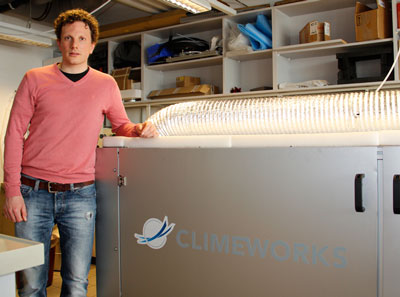| Jul 05, 2013 |
Prototype for the CO2 vacuum cleaner
|
|
(Nanowerk News) ETH-Zurich spin-off Climeworks is looking to filter carbon dioxide out of the ambient air and sell it to major customers such as greenhouses at competitive prices. The first pilot plant is up and running and the equipment is expected to filter up to 1,000 tons of carbon dioxide out of the air a year by 2014.
|
|
Zurich’s Technopark has blossomed into one of the main hotbeds for ETH-Zurich spin-offs in recent years. With its eight employees spread over four offices, Climeworks has also found its entrepreneurial home here. Half of the start-up company’s development lab is currently taken up with a great big matt-silver box – the first prototype of Climeworks’ product: a CO2 filter system. Two insulated tubes as thick as arms connect the box to two holes in the balcony windows. One of them draws in air from outside via a pump, the other blows it back into atmosphere – after it has been cleaned of carbon dioxide (CO2).
|
|
Only 0.04 per cent of the ambient air is CO2, which is primarily produced during the combustion of fossil energy sources and chiefly responsible for the climate change humans have caused. In the Climeworks prototyp, the carbon dioxide is bound (adsorbed) chemically by a novel filtration material. As soon as the filter is saturated, the gas is separated from the filter again by heating it to ninety degrees Celsius. The result: carbon dioxide with a purity of ninety-nine per cent. Almost fifteen years of research and development work have gone into the prototype: ten years of basic research by Professor Aldo Steinfeld at ETH Zurich’s Institute of Energy Technology and another four years of development by his two doctoral students and Climeworks founders Jan Wurzbacher and Christoph Gebald.
|
 |
| This inconspicuous box next to Climeworks co-founder Christoph Gebald has got a lot to offer: The prototype filters up to four kilograms of carbon dioxide a day out of the air.
|
|
Optimised for higher efficiency
|
|
“The biggest developmental step is now behind us,” says Gebald. “For a long time, we were only able to obtain a few grams of CO2 from the air in the lab. Today, our prototype adsorbs up to four kilograms a day.” Over the period of four years, Climeworks has managed to scale the system by a factor of 1,000. According to Gebald, the latest measurement data reveals that the current prototype has come on in leaps and bounds in terms of the system’s design and efficiency.
|
|
Unlike other cleantech start-ups, Climeworks’ business model is not based on climate compensation payments for CO2 sequestration. Instead, the company expects to draw its profits from the sale of the gas to large-scale consumers such as greenhouses. Because plants store CO2 in their biomass for growth, the concentration in the ambient air decreases and constantly needs to be replenished. Studies have revealed that the yield is as much as thirty per cent higher as a result. Consequently, Climeworks is currently planning its first CO2 adsorption plant for a four-hectare greenhouse. The advantage for the customer: they no longer need to transport the CO2 in from afar as they can produce it right on site.
|
|
All down to CO2 price
|
|
But it has to make economic sense: the average CO2 price for Europe is currently CHF 100 per ton. However, it fluctuates considerably because eighty per cent of the CO2 traded globally is generated as a by-product of ammoniac production and the price is governed by the main product. It also depends greatly on the transport route. As for the pilot plant in the lab, the costs per ton of CO2 are currently “many orders of magnitude” higher, as Gebald puts it. Ultimately, it is still a one-off production. However, this should soon change: “We’re pursuing a modular concept,” explains Gebald. The idea is for future industrial plants to be composed of a large number of individual devices, which would enable the modules to be standardised and produced in high quantities, thereby reducing the cost per unit.
|
|
Accordingly, the plant for the greenhouse is constructed from twenty coupled devices. From early 2014 it should filter 1,000 tons of CO2 a year out of the air. Whether this succeeds chiefly depends on the energy costs for operating the plant. The separation of the CO2 at ninety degree Celsius especially requires a lot of low-temperature heat. On the other hand, powering the pump and controls only constitutes five per cent of the overall energy consumption. Really, operating the plant with solar power would be the most elegant solution. For reasons of cost, however, this is out of the question in northern climes. Consequently, Climeworks is currently exploring the options of external heat from refuse incineration plants and combined heat and power units.
|
|
Sun in the tank
|
|
In the longer term, however, Climeworks has another market in its sights: along with hydrogen, CO2 can by synthesised into syngas (see article in ETH Life), which in turn forms the basis for the production of kerosene, gasoline and diesel. Ideally, the energy for this should come from the sun as the solar power could be stored in the form of liquid fuel. Although the amount of CO2 already emitted globally would not be reduced as a result, it could be retained in a cycle. The problem: a refinery is required to convert the syngas into liquid fuel and this would only be worthwhile from a certain size. “We’re talking about investments to the tune of several hundreds of millions to billions, not projects that a small spin-off could carry,” says Gebald. We still have a long way to go before we reach that stage.
|

